Read all of art critic David Apatoff’s columns here.
The first time I attended the annual convention of the National Cartoonists Society I looked around suspiciously. The artists seated in the hotel ballroom all looked pretty normal to me. They each had only one head and dressed like ordinary human beings. Yet, these were the creative oddballs responsible for the hilarious and offbeat comics that we see in newspapers, comic books, and magazines.
Then one of the cartoonists stood up. “As many of you are aware, he began soberly, “this year we lost our dear friend and long-standing member, Roy. In his memory, we will observe a moment of… complaining.” The room erupted: “The air conditioning in this hotel sucks!” called out one voice. “Your room is better than mine!” complained another. Pandemonium descended as, for a full minute, Roy was administered a cartoonist’s version of last rites.
Clearly there was going to be nothing conventional about a convention of cartoonists.
Every year, cartoonists from all around the country (and a few from overseas) gather at the NCS convention to renew friendships, swap stories, and celebrate the achievements of their peers. Many groups hold conferences in hotels or convention centers, but one year the NCS took over Elvis Presley’s mansion, Graceland, for their event. We were watching “the King” on a big screen dancing with a Vegas showgirl in a sparkly bikini when a voice called out from behind me, “Hey!! That’s my wife!!!” With cartoonists, nothing surprises me anymore.


When the cartoonists gather, they bestow an award called “The Reuben” on the outstanding cartoonist of the year. The Reuben is the cartoonist’s equivalent of an Oscar, except it looks a little different.
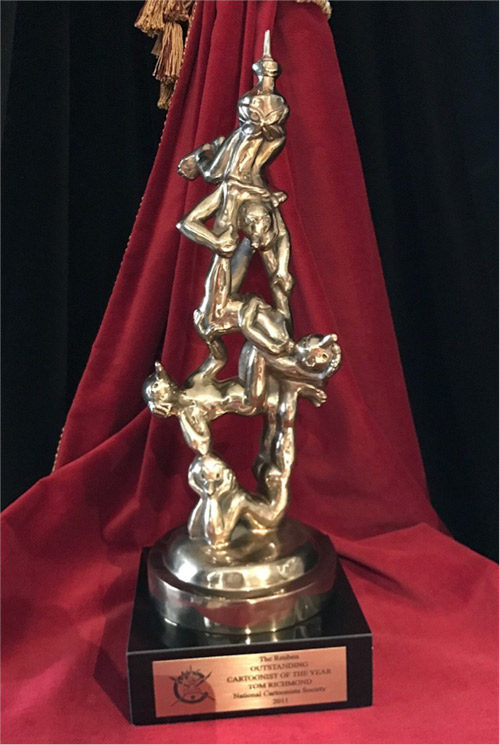
The Reuben is named after cartoonist Rube Goldberg. As this year’s invitation noted, “Everyone knows the name of NCS co-founder Rube Goldberg — cartoonist, humorist, sculptor, author, engineer, and inventor — but it’s been almost 50 years since his death, and his output has slowed down considerably.”
Comics, like jazz, are one of the few genuine American art forms. Like jazz, comics were disparaged for years, but critics have grudgingly come to recognize that comics are responsible for some of the best pen and ink drawing of the 20th century. Original drawings by cartoonists are now praised as legitimate art in distinguished museum collections. This year, the comic strip Krazy Kat was honored in a major exhibition in Spain at one of the leading contemporary art institutions in the world. Comics are also responsible for many of our cultural icons; they’ve shaped our vocabulary and provided much of our folklore, myths and legends.
Great Americans have aspired to be cartoonists but could not make the grade, so they had to find employment elsewhere. These include Hugh Hefner, Pulitzer prize-winning novelist John Updike, comedian Jonathan Winter, CNN news anchor Jake Tapper, and actors Ginger Rogers, Jane Powell, and Jackie Gleason. None of them was good enough.
On the other hand, several cartoonists who did become successful got their start submitting gag cartoons to The Saturday Evening Post. Three of the greatest, most popular cartoonists in history — Charles Schulz who went on to create Peanuts, Mort Walker who created Beetle Bailey, and Hank Ketcham who created Dennis the Menace — all worked in their early days for The Saturday Evening Post and went on to make fortunes with their own syndicated strips.
In 1935, when women cartoonists were still a rarity, Marjorie Henderson Buell created the irrepressible character Little Lulu for the Post.
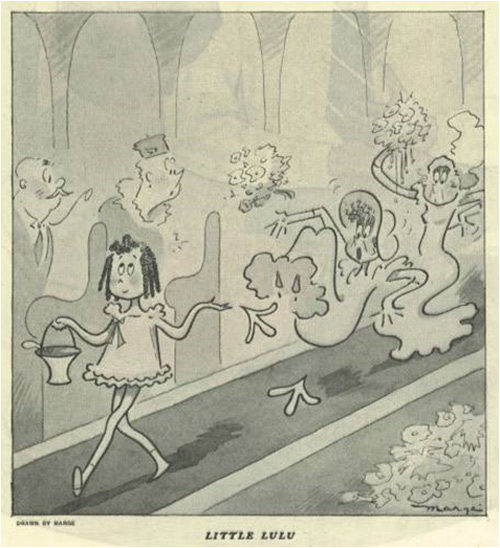
Lulu became a smash hit, and she was especially popular with nascent feminists who admired her moxie.

Decades later, a group calling itself “Friends of Lulu” would convene in her name to celebrate her spirit.
Today, conditions are much better, and some of the most popular cartoons are written and drawn by talented and enterprising women cartoonists. They banded together for a group photo after this year’s panel on “Women Pioneers of Cartoon Art”:
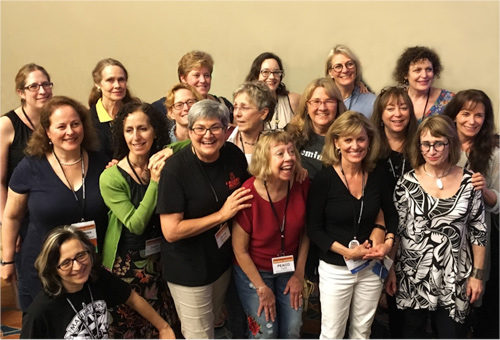
Another popular group this year were the cartoonists from MAD, the irreverent magazine that has influenced the taste and sense of humor of an entire generation.

Some of the creative talents responsible for MAD conducted a popular panel along with fans and collectors at the convention.

It has been said that producing a daily comic strip is like “running in front of a train.” Many cartoonists write and draw new material every day of the week, with larger installments on Sunday. Cartoonists work long hours hunched over a drawing board trying to meet deadlines, so it’s no surprise that when they get out into the public and have an opportunity to socialize, some of them become enthusiastic.
This year’s convention included a two hour trivia contest with questions about the history of cartoons that ranged from obscure to surreal. At least a dozen teams competed in a hard fought battle, but in the end, the team “The Shmendricks” emerged triumphant.
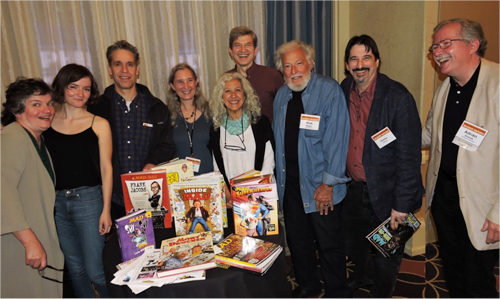
I now make a point of going to the NCS convention every year. There is no place on earth quite like it. For one thing, there are doodles everywhere, made by artists whose fingers itch to draw. While it is not always clear where a cartoonist’s head is, there is no doubt where their hearts are. Every year members of the NCS set aside substantial time for charitable work in their host city, visiting and entertaining sick children in local hospitals, using their talents to work with public libraries, the USO, and veterans’ hospitals. There is no more meaningful use of a cartoonist’s funny drawing skills than to cheer up a child with a serious illness.
Next year the convention will be held in Huntington Beach, California.
Become a Saturday Evening Post member and enjoy unlimited access. Subscribe now



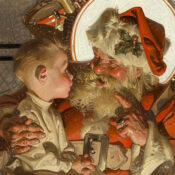
Comments
I’d like to point out that the unknown cartoonist, back row at left, in the Women Pioneer photo is magazine/New Yorker cartoonist, Ali Solomon.
You captured the delightful madness of a Reuben Awards weekend perfectly, David.
The figure I spoke about may have been made by Hummel
I have a Norman Rockwell figure that was made in England and it is a man soaking his feet and a lady feeding him medicine. Can you show me a pic of it and the name?? thank you, Shirley
shirley
are there any photos of Charles Beach, the Arrow Collar Man?
are there any photos of Charles Beach? He was featured so many times in Leyendecker’s work I wonder if his photo matches the characters that Leyendecker created.
Wow. Were any cartoonists of color involved in NCS? Either they weren’t included in pictures, or they weren’t invited…
Thank you David for your kind words, and looking into David Folkman for me. Jen Bortel has my e-mail, and is always so kind, helpful and gracious.
Very sorry to hear about Nick Meglin. Death is always terrible, but even more so when you just saw him—only a few days earlier—and he was fine. That greatly ups the shock value. Not a few months or even weeks to somewhat cushion the loss. Mere days is really rough. It’s a surreal shock that will take time to normalize from.
On the upside he got to attend the convention, and all you guys (and gals!) got to have some MAD cap fun with him, even if it was unknowingly for the last time.
Jason Chatfield– Thanks for the independent verification. A couple of people have said to me, “That can’t possibly be true.” It’s nice to have an eye witness!
Potter Zebby– Yes, that was indeed the famous Norman Mingo. I’m sorry to say that following the Reuben awards this year, the witty Nick Meglin, who came up with the idea for that cover, also passed away. He was always a center of fun every year and will be sorely missed.
Bob McGowan, Jr.– You are always a fountain of information on these matters. It’s amazing. I have a few old magazines stored in boxes too, and keep intending to get back to them.
In addition to Cathy Guisewite, you may recognize Lynn Johnston who drew the hugely popular, “For Better or Worse” strip for decades. I’ve sent out an inquiry to see if this David Folkman is the same as your David Folkman.
Ha! Wonderful post. Thank you!
The gentleman we were posthumously roasting was famed illustrator Roy Doty, who was famous for his well-meaning kveching.
The cartoonist whose wife was one of Elvis’ backup dancers was the great Sergio Aragones of MAD fame.
Never a dull moment at the Reubens!
That December ’74 ‘Zing the Sting’ MAD cover is a true classic. The real movie borrowed heavily from The Saturday Evening Post style, and whoever did the poster REALLY knew how to copy Leyendecker, to the point of being uncanny.
That was Norman Mingo, who was 78 years old when he did the cover, and would have been thoroughly familiar with both Leyendecker’s work and heyday. He drew MAD covers until shortly before his death in 1980.
The NCS convention sounds like an event where you get to meet a lot of fun, creative people! Although I never would have associated it as a cartoonist convention site, Graceland seems like a perfect place; why not?!
Very glad to see women are getting into the field in a pretty big way now, and are being recognized. The only name I know from this group is Cathy Guisewite. I’m not sure if these women also draw daily-paper-strips and/or political cartoons, etc.
That December ’74 ‘Zing the Sting’ MAD cover is a true classic. The real movie borrowed heavily from The Saturday Evening Post style, and whoever did the poster REALLY knew how to copy Leyendecker, to the point of being uncanny. I bought that issue new for 50 cents (my God!), and still have it in my storage. I subscribe to it now, and still feel it’s a great publication.
I noticed the bottom photo of the Shmendricks was taken by David Folkman. If he’s the same guy I think he is, I met him at The Bookie Joint back issue magazine and used book store in Reseda, Ca. I was working for the owner (Rose Blaz) as a volunteer in my spare time after the horrible Northridge earthquake in ’94. I know she’d love to hear from him. She’s doing well at 91. I see her fairly frequently to take her shopping and help with chores.
He was the Art Director for the revived quarterly Liberty—Then & Now magazine (1971-’76) which at first were reprints of old issues, then branched out to the then and now format in ’73, with all-new really gorgeous covers including a ‘Peanuts’ cover by Charles Schulz featuring ‘The Great Cartoons of the Century’! He came in to buy the back copies we had of the ’73-’75 issues he’d worked on years earlier, and we had them all fortunately.
The magazine changed hands (New York to California) in late ’75, then folded with the Fall ’76 issue featuring the still beautiful Ginger Rogers on the cover. I still have those great ’73-’76 issues I bought new as a teenager in storage also. It’s high time to bring them home to enjoy once again now, I’d say.